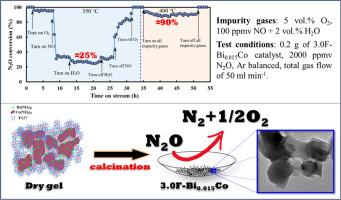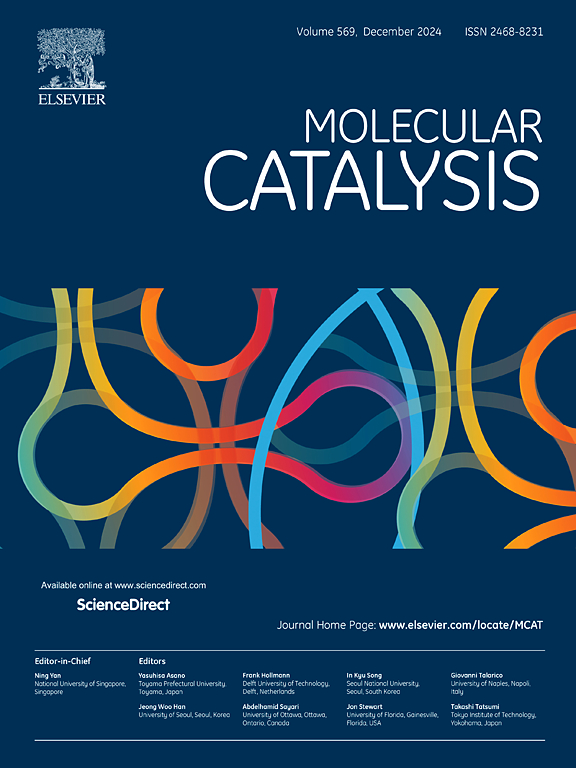F127 辅助合成用于在杂质气体存在时催化 N2O 分解的 Bi 促进 Co3O4 催化剂
IF 3.9
2区 化学
Q2 CHEMISTRY, PHYSICAL
引用次数: 0
摘要
本文在 F127 的帮助下,通过改进的溶胶-凝胶法成功制备了用于催化 N2O 分解的 Bi 促进 Co3O4 催化剂。研究发现,添加剂 Bi 的掺入不仅没有改变 3.0F-Co3O4 独特的 "雅当地貌 "微观结构,反而促使 Co3O4 暴露出更多的活性晶面,如 (422)、(533) 和 (620)。此外,添加剂 Bi 的掺杂也提高了催化剂的比表面积,并进一步削弱了表面 Co-O 键。最佳的 3.0F-Bi0.015Co 催化剂在 300 °C 时实现了 >88 % 的 N2O 转化率(2000 ppmv N2O/Ar,GHSV=20000 h-1),相应的 TOF 值从 3.0F-Co3O4 的 1.50 × 10-3 s-1 提高到 3.63 × 10-3 s-1。同时,3.0F-Bi0.015Co 的 Ea 值低至 47.0 kJ mol-1。最重要的是,该催化剂具有良好的抗 O2 和 H2O 能力。在苛刻条件下(反应体系中同时存在 5 vol.% O2、100 ppmv NO 和 2 vol.% H2O),3.0F-Bi0.015Co 催化剂在 400 °C 下的 N2O 转化率可稳定在 90% 以上。本文章由计算机程序翻译,如有差异,请以英文原文为准。

F127 assisted synthesis of Bi promoted Co3O4 catalyst for catalyzing N2O decomposition in presence of impurity gases
In this paper, Bi promoted Co3O4 catalysts used for catalyzing N2O decomposition were successfully prepared by improved sol-gel method with the assistance of F127. It was found that the doping of additive Bi not only did not change the unique “Yardang Landform” microstructure of the 3.0F-Co3O4, but also prompted Co3O4 to expose more active crystal planes, such as (422), (533) and (620). Moreover, the doping of the additive Bi also enhanced the catalyst's specific surface area, and further weakened the surface Co-O bond. The optimum 3.0F-Bi0.015Co catalyst achieved >88 % N2O conversion (2000 ppmv N2O/Ar, GHSV=20,000 h−1) at 300 °C, and its corresponding TOF value increased from 1.50 × 10−3 s−1 for 3.0F-Co3O4 to 3.63 × 10−3 s−1. Meanwhile, the Ea of 3.0F-Bi0.015Co was as low as 47.0 kJ mol−1. Most importantly, the catalyst has good resistance to O2 and H2O. Under the harsh condition (both 5 vol.% O2, 100 ppmv NO and 2 vol.% H2O were coexisted in the reaction system), the N2O conversion over the 3.0F-Bi0.015Co catalyst can be stable above 90 % at 400 °C.
求助全文
通过发布文献求助,成功后即可免费获取论文全文。
去求助
来源期刊

Molecular Catalysis
Chemical Engineering-Process Chemistry and Technology
CiteScore
6.90
自引率
10.90%
发文量
700
审稿时长
40 days
期刊介绍:
Molecular Catalysis publishes full papers that are original, rigorous, and scholarly contributions examining the molecular and atomic aspects of catalytic activation and reaction mechanisms. The fields covered are:
Heterogeneous catalysis including immobilized molecular catalysts
Homogeneous catalysis including organocatalysis, organometallic catalysis and biocatalysis
Photo- and electrochemistry
Theoretical aspects of catalysis analyzed by computational methods
 求助内容:
求助内容: 应助结果提醒方式:
应助结果提醒方式:


